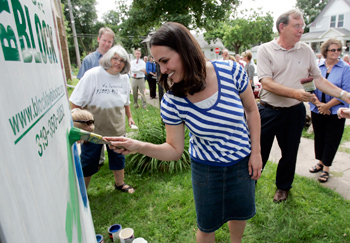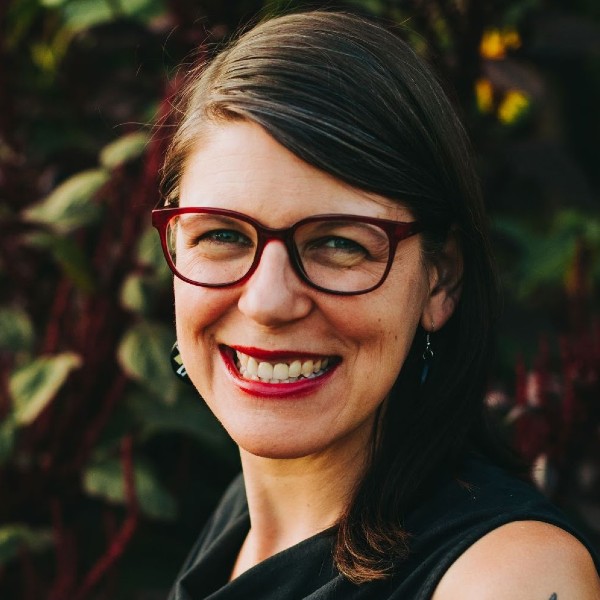On a frigid winter day, there are new signs of life in the 1300 block of Eighth Street on the northwest side of Cedar Rapids, Iowa.
Sidewalks are cleared of snow, smoke rises from chimneys and kitchen lights glow behind new curtains. A block away, for-sale signs dot lawns of freshly painted houses, electricians’ trailers rest on curbs and power tools buzz in the distance.
Many in this working-class neighborhood thought they’d never return after the Cedar River overflowed its banks and saturated about 10 square miles, or 14 percent, of the city in June 2008. Almost a year later, many people still waited while their homes sat empty.
But the dedication of two brothers, an innovative church-community partnership and a common faith in neighborly love brought them home again.
Known as Block by Block, the neighborhood revitalization project has been hailed as one of the most successful efforts in Cedar Rapids. Instead of helping homeowners one at a time, Block by Block works to bring back entire neighborhoods.
Though it melds a unique array of religious and secular groups, the heart of the project is ultimately Christian: building communities of people who take care of one another.
“The early church evolved through a neighbor talking to a neighbor, saying, ‘We’re building this community. When you get hurt, when you are suffering, this community of believers will help you heal,’” said the Rev. Clint Twedt-Ball, a United Methodist pastor who came up with the idea for Block by Block. “To me, that’s what Block by Block is about. When disasters happen, we as Christians will come together to help neighbors get whole again.”
A river’s devastation
The Cedar River flows through downtown Cedar Rapids, an eastern Iowa city of about 124,000 people. When the river crested at more than 31 feet in June 2008, floodwaters swept through downtown and the surrounding neighborhoods, soaking more than 7,000 properties, including about 5,000 homes, according to Corridor Recovery, a flood resource clearinghouse.
Questions to consider
Questions to consider:
- In Cedar Rapids, the church and its partners were able to respond more quickly than the government to community needs. Is there something in your area that your church could respond to in similar ways?
- In thinking about your community, what are its assets? Which of these are presently under-utilized? Who are the community partners with whom your institution could work to take advantage of these assets?
- Block by Block has known its share of criticism. Do you agree with Twedt-Ball that “when you voluntarily go into places where people are hurting, you have to be open to criticism?” How do you deal with criticism of projects in which you are involved?
- What lessons might we learn from this story that would improve our response to the recent disasters in Haiti and Chile?
Eleven blocks from the river, Katie and Andrew Sandquist had in spring 2008 just finished their basement and redone the hardwood floors on the first level of their early-20th-century home. The young couple bought the home in 2006 because they loved its big front porch and historic details.
The neighborhood, where elderly residents gathered on porches and children called out on the way to school each morning, was a mix of single-family homes and rental properties. While most residents took pride in their homes, some of the properties were in disrepair. The neighbors were friendly, but the Sandquists knew few of them well.
Like many of their neighbors, they moved everything from the basement to the first floor when they learned of the flooding threat, believing that water would seep into their basements but no higher.
In fact, the floodwaters engulfed much of the first story of every surrounding house. Days after the water receded, neighbors returned to find a mud-coated, tangled mess of furniture and appliances.
“I sobbed when I saw it,” Katie Sandquist said of pulling up to her home for the first time. “My life was in piles on the curb. It was devastating.”
Ministering to those on the margins
Months after the flood, progress was achingly slow. Many homeowners waited for government assistance to help them rebuild. They languished on waiting lists for overwhelmed plumbers and electricians. Others, who could not return, waited for government buyouts.
“Time went by and so much was still broken,” Katie Sandquist said. “People in my neighborhood were feeling hopeless.”
For many homeowners, frustration with bureaucracy was also fueling anger, said Twedt-Ball’s brother, the Rev. Courtney Ball, whose home was among those flooded.
“People in my neighborhood needed a chance to sit down and talk to each other, to share triumphs and resources,” said Ball, who began to organize informal neighborhood get-togethers.
The brothers, who come from a long line of Methodist pastors, know something about community organizing. When they were young, their father left his church and became the first full-time director of Habitat for Humanity in Des Moines. Their mother worked with immigrants, helping them get acclimated to the community. After seminary, the brothers settled into traditional congregations in eastern Iowa. But something was missing in their suburban churches; they felt called to minister to those on the margins.
An urban Cedar Rapids Methodist church gave the brothers space to start their community-building ministry in 2006. Named for Matthew 25:34-40, a passage about helping the less fortunate, Matthew 25 Ministry Hub offered services like free meals and tutoring to those in Cedar Rapids’ neediest west-side neighborhoods.
Their approach was based in part on the ideals of a movement known as asset-based community development, which builds upon a community’s strengths instead of focusing on its weaknesses. A consultant visited with them and urged them: Learn to love the neighborhood around you, build relationships, and then give people the tools they need to succeed.
The brothers were still getting to know the neighborhoods when the 2008 flood struck the area. In the early months after the flood, Matthew 25 helped homeowners gut and clean their homes. Working closely with neighbors put them in a unique position to see the problems with flood recovery in Cedar Rapids -- and to offer solutions. A tool library started by the ministry, for instance, allowed people to borrow tools free of charge and begin renovations quickly.
“The floods ended up presenting an enormous opportunity to bring about change in the community,” Ball said.
Offering a solution
Almost a year after the flood, much of the city was rebuilding. But many west-side neighborhoods were still filled with abandoned homes. Twedt-Ball approached the Affordable Housing Network Inc. with his vision for a new initiative, Block by Block: give people the resources to improve their homes and neighborhoods; make quick, visible progress; empower people to shape the future of their communities.
Jim Ernst, executive director of the nonprofit low-income-housing group, thought the idea had the potential to revitalize a variety of neighborhoods, not just those affected by the flood. He spoke with John Smith, CEO of CRST International. Smith, a lifelong Cedar Rapids resident, was also frustrated by the lack of post-flood progress on the west side of town and looking to put money toward a solution.
“When I heard about this idea, it was like a light went on,” Smith said. “I thought, ‘How simple -- and wow, what a difference it could make.’” He and wife Dyan pledged $1 million.
Other backers included the Greater Cedar Rapids Community Foundation, which offered $700,000. This rebuilding program was different, said Dan Baldwin, past president of the foundation, because it offered what government couldn’t: a promise to get work done quickly, customized solutions and an approach that would have a long-term impact on neighborhoods.
“What Block by Block presented was a nimble, streamlined attempt to actually bring people within a neighborhood together and have everyone participate in its renewal,” Baldwin said. “The problem was if there were 16 houses on a block, maybe only four people had the fortitude to rebuild. This was a chance to create real, critical mass in rebuilding neighborhoods, which are the fabric of every community.”
Signs of recovery
Launched in summer 2009, Block by Block works with neighborhoods that request the program’s help.
“There’s this community organizing phrase, ‘It’s not about me without me,’” Twedt-Ball said. “We don’t want to do it for them; we want to do it with them. We want the neighbors to gather their other neighbors together, and then we’ll give them the tools to make progress.”
Once at least 60 percent of property owners on a block agree to participate, those homeowners meet with Block by Block staff members to discuss the desired outcomes for their homes. About 80 percent of them fix up their homes and stay. The rest choose to sell their property. Block by Block commits to finding solutions for most properties within 120 days.
Those who decide to repair their homes receive volunteer labor and donated supplies from Block by Block. If a homeowner decides to sell, Block by Block may purchase the home at pre-flood assessed value and rehabilitate it for sale at an affordable price.
Because the program is supported largely by private funds, renovations or buyouts can happen faster than those programs sponsored solely by government. And thanks in part to a partnership with the United Methodist Church, more than 10,000 volunteers from across the country have traveled to Cedar Rapids to help renovate homes rapidly.
Their work was quickly visible. By Christmas 2009, Block by Block had completed most of eight blocks and 103 properties.
Block by Block goes a step beyond simple home repair. When a block signs on, neighbors agree that they will take care of their property and attend regular block meetings. They must also make decisions as a group about the neighborhood -- for example, deciding that an empty lot will become a picnic area or playground.
In the months after the flood, feelings of powerlessness fed apathy, Ball said. Block by Block puts the power to improve their lives back in the hands of residents.
“When we walk away from a block, people there know each other,” Ball said. “They’re really comfortable calling each other up, having barbecues and potlucks. Not only are we repairing homes, but we’re building up neighborly relationships.”
The project has brought together diverse community partners who each offer specific skills. Matthew 25 works on relationship building; the United Methodist Church offers its vast network of volunteers and financial resources; and the Affordable Housing Network gives fiscal oversight and regulatory know-how.
“Innovation in the church frequently comes slowly and often in unexpected ways,” said Bishop Julius Calvin Trimble of the Iowa Conference of the United Methodist Church. “Through their openness to a vision from God and persistent leadership in sharing that vision, [the brothers] have established a ministry where exciting, collaborative partnerships … have accomplished more than anyone could ever anticipate.”
Though they sometimes disagree about how to accomplish goals, the partnership works because everyone shares a common purpose to rebuild the community, Twedt-Ball said.
“While we aren’t all faith-based, I do think there is a common faith in humanity and in love of neighbor that we all share even if we don’t talk about it in terms of the same God,” Twedt-Ball said. “There’s a commitment to something bigger than ourselves and our organization.”
Still, there have been critics. Some have called Block by Block a group of “Bible thumpers” using neighborhood redevelopment as a cover for proselytizing. While the criticism has angered him at times, Twedt-Ball said it reinforces the need for the organization to be open and honest about its work. And, most importantly, Block by Block must deliver results.
“When you voluntarily go into places where people are hurting, you have to be open to criticism,” he said. “Part of what it means to be Christ-like is to take a beating and move forward.”
‘Healing a community, not just a house’
By the end of 2010, Block by Block hopes to work with another 12 to 16 blocks, or about 300 property owners. In all, about 20 percent of properties in the hardest-hit area of Cedar Rapids will have been touched by Block by Block.
Recovery work still remains to be done. Near the Sandquist home are blocks filled with boarded-up homes, their porches still piled high with flood debris.
But progress continues: A team of Block by Block volunteers helped the Sandquists complete work on their basement, which they had just finished before the flood, and other smaller projects that remained.
“You just reach a point where you can’t handle another week, where you feel like you’re pushing and pushing to get the work done,” Katie Sandquist said. “It was a relief to be able to finally wrap things up.”
More importantly, Block by Block helped them get to know their neighbors and get more involved in their neighborhood. Now that most of the immediate flood recovery is behind them, the neighbors are coming together to advocate for things such as sidewalk repair and street maintenance.
“Seeing this actually work, seeing the momentum grow, has been uplifting,” Katie Sandquist said. “Now we feel like we can effect change in our neighborhoods. I think it’s been an incredibly healthy process to make our community stronger.
“This project is healing a community, not just a house,” she said. “This is going to be something that makes our neighborhood stronger forever.”












